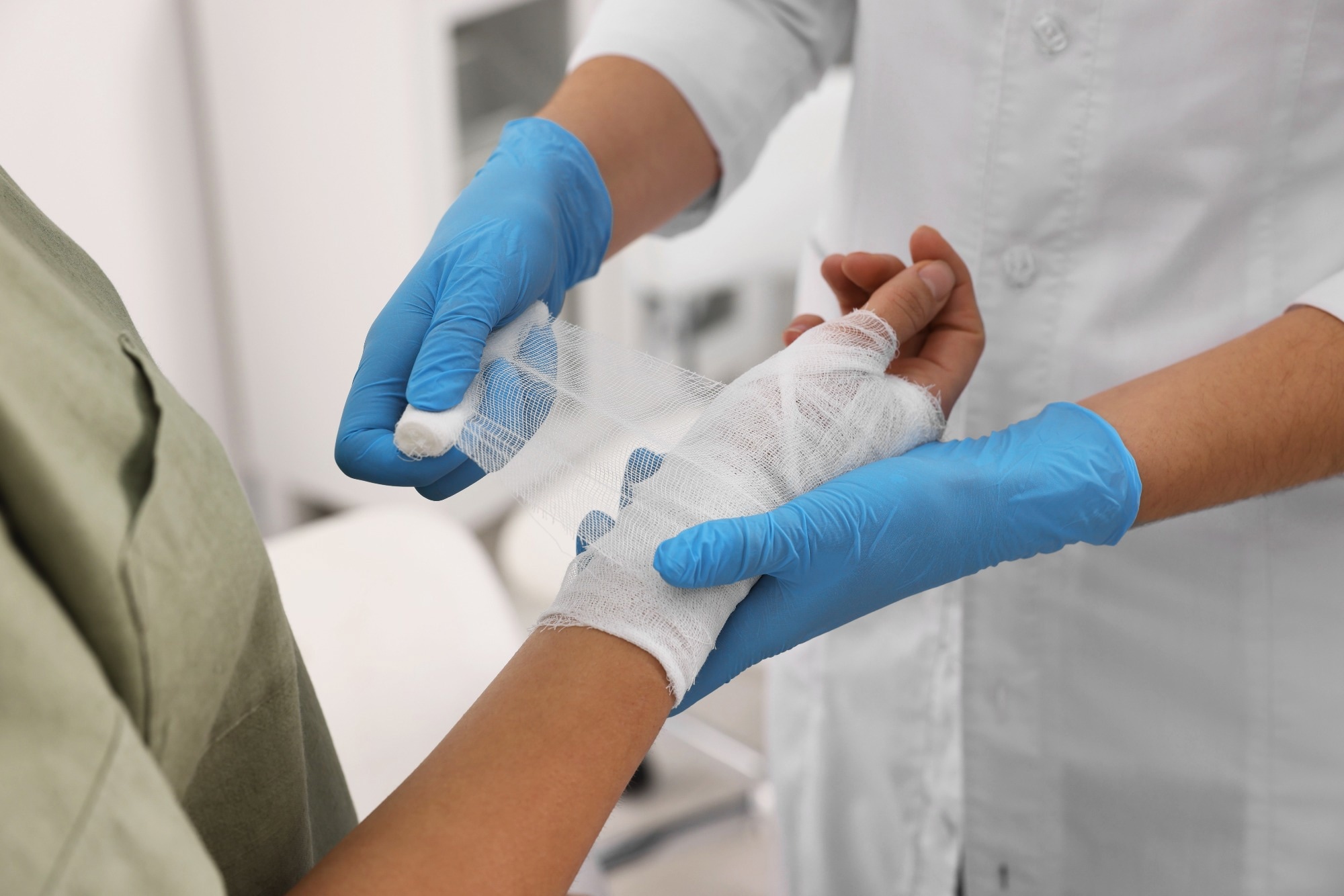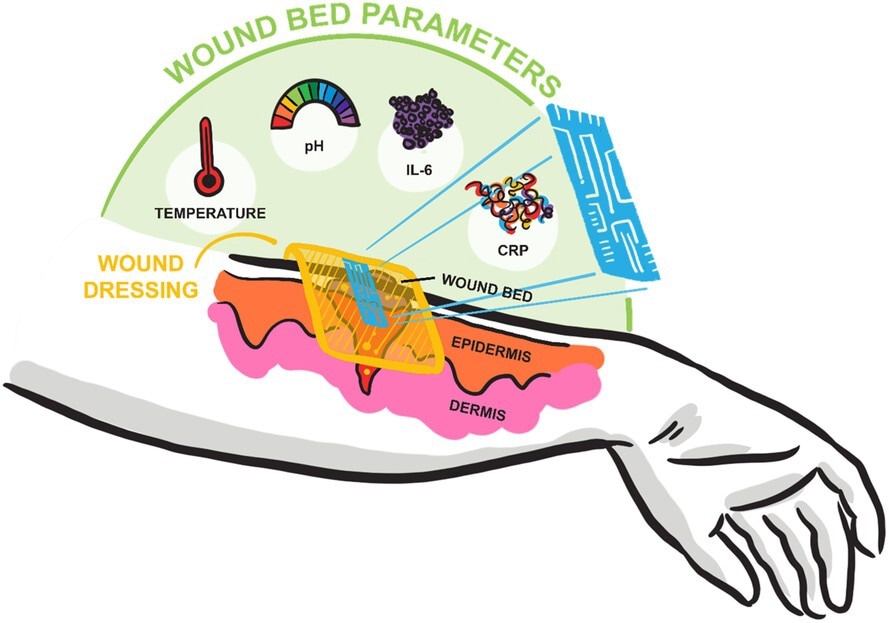A Bluetooth-enabled flexible sensor patch from RMIT lets doctors and patients see inside a healing wound without lifting the dressing, spotting problems early, and keeping recovery on track.
 Study: Multiplexed Cutaneous Wound Monitor for Point-of-Care Applications. Image credit: New Africa/Shutterstock.com
Study: Multiplexed Cutaneous Wound Monitor for Point-of-Care Applications. Image credit: New Africa/Shutterstock.com
Researchers at the Royal Melbourne Institute of Technology (RMIT), Australia, developed a wearable wound monitoring device to ease chronic wounds and infections by reducing the need for frequent physical contact. A detailed report is published in Advanced NanoBiomed Research.
Background
Wearable wound monitors are medical devices used for continuous monitoring of wound healing progression. These devices are gaining considerable attention in healthcare sectors due to their ability to provide a vast amount of useful data to healthcare professionals and reduce the need for frequent consultations.
Wearable wound monitors contain a range of sophisticated sensors and intricate algorithms, which help quantify various parameters, including wound-site temperature, humidity, pressure, and specific wound bed biomarkers. This information helps healthcare professionals evaluate the progress of wound healing and facilitate their wound care and treatment-related decision-making.
With the growing popularity of wearable wound monitors, the RMIT researchers developed a multiplexed cutaneous wound monitor using a “triangulated” approach with advanced integrated sensor technology to track various biomarkers and biophysical parameters related to wound health and study how these parameters interact with each other.
The wearable wound monitoring device
This flexible, reusable wound monitoring device contains high-resistive silicon (HR-Si) conductometric biosensors to detect inflammatory biomarkers, a potentiometric pH sensor, and a temperature sensor. Bluetooth is also incorporated to transmit data remotely for reading via an Android smartphone app (“FMM Connect”). This would reduce the need for frequent dressing removal and physical contact with the wound.
The researchers focused on two inflammatory biomarkers: interleukin 6 (IL-6) and C-reactive protein (CRP). These biomarkers play crucial roles in wound healing. IL-6 is released in the initial phase of wound trauma to promote tissue repair by releasing proinflammatory cytokines. CRP, in turn, induces phagocyte-mediated destruction of dead cells and pathogens, thereby promoting tissue repair.
The other two sensors were used to continuously monitor the changes in two vital biophysical parameters at the wound site, i.e., high temperatures indicating inflammation or infection, and pH changes indicating different stages of wound healing. Normal vs. abnormal thresholds for these parameters were defined in the study; for example, IL-6 < 45 nM and CRP < 40 nM indicate normal healing, while IL-6 > 45.36 nM and CRP > 41.67 nM suggest chronic infection. Similarly, a pH above 7.4 or a temperature above 38 °C can indicate infection or necrosis.
The researchers incorporated these sensors on a system-on-chip platform enabled with Bluetooth technology, which interfaces with a custom-developed phone application.
 Schematic showing the triangulated approach used in monitoring wound healing. The parameters being studied are CRP, IL-6, pH, and temperature.
Schematic showing the triangulated approach used in monitoring wound healing. The parameters being studied are CRP, IL-6, pH, and temperature.
Functional validation
The researchers tested the monitor's functionality by simulating conditions in the laboratory and demonstrating fit and flexibility by placing the monitor on a human arm to show that it conforms well to the curved surface.
As the researchers stated, one advantage of the monitor is that its flexible sensors can be placed on or next to a wound under dressings. Their flexibility makes them adaptable to different wound shapes and body areas.
For inflammatory biomarker monitoring, the sensors were immobilized with CRP and IL-6 antibodies and then CRP and IL-6 antigens, respectively, for specific measurements. Any changes in the levels of inflammatory biomarkers in response to wound trauma were indicated by the percentage change in the resistance of the sensors, which correspond in the app to respective changes in voltage values in mV.
For temperature monitoring, the sensor response was measured as a change in output voltage to a change in temperature. The output voltage decreases with increasing temperature.
The sensors were hydrated for pH monitoring to improve surface activation, and open circuit voltage measurements were taken for the sensor over a broad range of pH. Moreover, temperature-dependent pH measurements were carried out, showing that the potential increases correspondingly with increasing temperatures. This allowed the team to assess interdependence between pH changes and biomarker responses.
Utility and significance
The study provides proof-of-concept of a wearable wound monitoring device enabled with wireless Bluetooth technology. The device shows high efficiency in continuously monitoring changes in inflammatory biomarker levels, pH, and temperature at the wound site, which are critical in understanding the progression of wound healing.
About 500,000 Australians are affected by chronic wounds, which collectively cost the national healthcare system around $3 billion each year. Globally, the problem affects millions of patients.
This low-cost device could be a more practical alternative to disposable smart bandages and other digital health products. It could address a widespread healthcare challenge, particularly for patients with chronic wounds. The electronics module is reusable, while the HR-Si and pH sensors are designed to be replaced with each dressing change.
The HR-Si-based sensor technology used in the device has already been applied to other medical devices to detect multiple biomarkers.
Overall, the study highlights the device's applicability in remotely monitoring the phases of wound healing in real time. As the researchers mentioned, future studies could aim to develop a digital application tuned to each sensor individually, offering data visualization with an improved user interface.
The authors also note that the approach could be adapted for other point-of-care diagnostic applications by integrating additional biomarker sensors.
Download your PDF copy now!